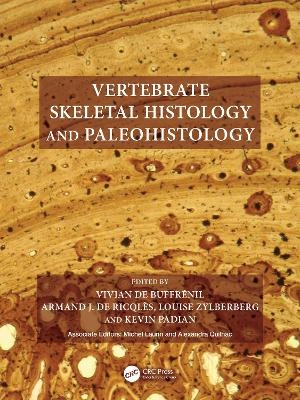
Vertebrate Skeletal Histology and Paleohistology
Crc Press Inc (Verlag)
978-0-8153-9288-0 (ISBN)
- Titel z.Zt. nicht lieferbar
- Versandkostenfrei innerhalb Deutschlands
- Auch auf Rechnung
- Verfügbarkeit in der Filiale vor Ort prüfen
- Artikel merken
Vivian de Buffrénil received a double university degree: history, through a master’s degree, specialized in the history of sciences (Paris 1972), and biology, through a PhD (Paris, 1980) as well as a “thèe d’éat” (Paris 1990). His professional career began in 1982 as a “maîre de conferences” at the Musém National d’Histoire Naturelle, Paris, where he remained until 1986. Since the beginning, Buffréil’s research activity has been related to comparative bone histology and paleohistology in extant and extinct mammals, reptiles and amphibians. About one hundred scientific articles were published on this subject. In parallel, Buffrénil took an active part in international programs led by CITES and FAO (two UN institutions) on the conservation of exploited reptiles, especially African monitor lizards and crocodiles and produced many expert reports. Louise Zylberberg received her university degrees at Le Centre national de la recherche scientifique with a double curriculum in biology and biochemistry. She defended her doctoral thesis in histology there in 1968. Her career began as a researcher at the CNRS (1961) and she continued as “directrice de recherche” (1977) until her retirement (2001). She is still active as “emeritus directrice de recherche”. Her research has focused on comparisons of the results obtained with conventional histology and more specialized ultrastructural techniques. Since joining the “Formations squelettiques” team in 1980, she has applied these techniques to the study of mineralized tissues of the skeleton of extant and extinct species including reptiles, amphibians and “fishes”. She is also familiar with immunological techniques and comparative histological and cytological analyses which have revealed the wide variety of skeletal tissues and possible relationships between these various tissues during development and during evolution. She has published about two hundred articles. Kevin Padian is Professor in the Department of Integrative Biology and Curator at the Museum of Paleontology at the University of California, Berkeley. He is the author or co-author of dozens of peer reviewed scientific journal articles and editor/co-editor of nearly a dozen books. Armand de Ricqlès got his university degrees in Paris with a double concenration in biology and earth sciences. He started his career at the Sciences Faculty of the University of Paris (1961-70) in comparative anatomy and histology, then at the University of Paris VII Denis Diderot (1970-95) where he defended his doctoral thesis in Paleohistology (1973) and got a full professorship in Evolutionary Biology (1983). There he developed a research team, "formations squeletiques," that became famous in developing the comparative histology of bone. He has been a Visiting Professor at the University of Chicago and at the University of California, Berkeley. In 1995 he was elected Professor at the prestigious Collège de France (Paris) as the Chair of "Historical Biology and Evolutionism" until 2010. During his career his interests in research and teaching, as well as popularization of science, have covered the fields of zoology, ecology, vertebrate paleontology, comparative anatomy and histology, phylogenetic systematics and, especially, the paleohistology of tetrapod vertebrates, a research field that he has largely expanded and introduced in several countries. Still currently active in this field, he has published several hundred papers in scientific research and popularization.
Foreword. Contributors. I: INTRODUCTION. Paleohistology: An Historical – Bibliographical Introduction. II: MORPHOLOGY AND HISTOLOGY OF THE SKELETON. An Overview of the Embryonic Development of the Bony Skeleton. The Vertebrate Skeleton: A Brief Introduction. Methodological Focus A: The New Scalpel: Basic Aspects of CT-Scan Imaging. Microanatomical Features of Bones and Their Basic Measurement. Methodological Focus B: Basic Aspects of 3D Histomorphometry. Bone Cells and Organic Matrix. Current Concepts of the Mineralization of Type I Collagen in Vertebrate Tissues. An Overview of Cartilage Histology. Methodological Focus C: Virtual (Paleo-)Histology Through Synchrotron Imaging. Bone Tissue Types: A Brief Account of Currently Used Categories. Methodological Focus D: FIB-SEM Dual-Beam Microscopy for Three-Dimensional Ultrastructural Imaging of Skeletal Tissues. III: DYNAMIC PROCESSES IN OSSEOUS FORMATIONS. Basic Processes in Bone Growth. Accretion Rate and Histological Features of Bone. Bone Remodeling. Remarks on Metaplastic Processes in the Skeleton. IV: TEETH. Histology of Dental Hard Tissues. V: PHYLOGENETIC DIVERSITY OF SKELETAL TISSUES. Introduction. Finned Vertebrates. Early Tetrapodomorphs. Lissamphibia. Early Amniotes and Their Close Relatives. Testudines. Lepidosauria. Sauropterygia: Placodontia. Sauropterygia: Nothosauria and Pachypleurosauria. Sauropterygia: Histology of Plesiosauria. Ichthyosauria. Archosauromorpha: From Early Diapsids to Archosaurs. Archosauromorpha: The Crocodylomorpha. Archosauromorpha: Avemetatarsalia – Dinosaurs and Their Relatives. Nonmammalian Synapsids. Diversity of Bone Microstructure in Mammals. VI: INTEGRATIVE QUESTIONS. Phylogenetic Signal in Bone Histology. Cyclical Growth and Skeletochronology. Aging and Senescence Processes in the Skeleton. Basic Principles and Methodologies in Measuring Bone Biomechanics. Interpreting Mechanical Function in Extant and Fossil Long Bones. Bone Microanatomy and Lifestyle in Tetrapods. Bone Histology and the Adaptation to Aquatic Life in Tetrapods. Bone Histology and Thermal Physiology. Bone Ornamentation: Deciphering the Functional Meaning of an Enigmatic Feature. The Histology of Skeletal Tissues as a Tool in Paleoanthropological and Archaeological Investigations. A Methodological Renaissance to Advance Perennial Issues in Vertebrate Paleohistology. Extended Table of Contents.
| Erscheinungsdatum | 28.06.2021 |
|---|---|
| Zusatzinfo | 4 Tables, black and white; 334 Illustrations, color; 68 Illustrations, black and white |
| Verlagsort | Bosa Roca |
| Sprache | englisch |
| Maße | 210 x 280 mm |
| Gewicht | 2720 g |
| Themenwelt | Studium ► 1. Studienabschnitt (Vorklinik) ► Anatomie / Neuroanatomie |
| Naturwissenschaften ► Biologie | |
| Naturwissenschaften ► Geowissenschaften ► Mineralogie / Paläontologie | |
| ISBN-10 | 0-8153-9288-5 / 0815392885 |
| ISBN-13 | 978-0-8153-9288-0 / 9780815392880 |
| Zustand | Neuware |
| Informationen gemäß Produktsicherheitsverordnung (GPSR) | |
| Haben Sie eine Frage zum Produkt? |
aus dem Bereich


